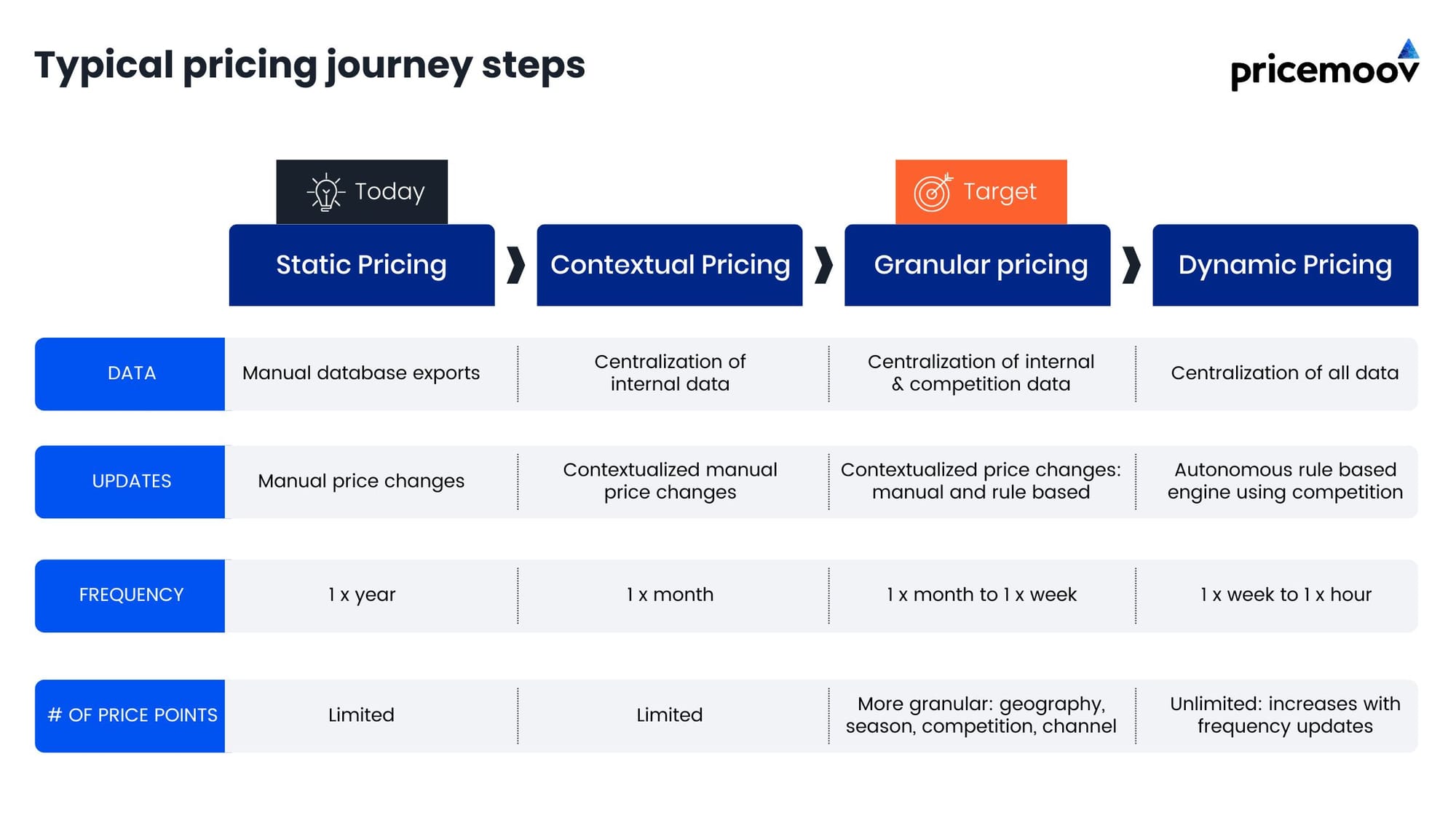Blog
Revolutionize Your Price Setting With Granular Pricing: A Prelude to Dynamic Pricing

author
Anya Policht
date of publication
December 13, 2023
time to read
5 minutes
As you navigate changing market conditions, do your fixed pricing strategies fall short of tapping into full revenue potential? If so, step into the world of granular pricing, an agile, data-driven approach transforming the conventional pricing landscape into a more nuanced and contextualized price-setting strategy.
What if you could break down your pricing into specific, adaptable components rather than sticking to a rigid, one-size-fits-all model? Granular pricing enables you to tailor your pricing to diverse customer segments, product variations, and distinct purchasing scenarios. Strategically boosting revenue across varied product lines and adapting prices to specific buying contexts, this approach ensures no missed opportunity.
Think of granular pricing as the precursor to dynamic pricing. Staying ahead in today's competitive marketplace means being adaptable, and granular pricing offers that. Ready to scale up your pricing strategy and witness a transformative change in how you do business? Let’s explore how granular pricing can revolutionize your approach and pave the way for effective price setting.
Defining your stage in the pricing journey
Have you ever wondered, "How do businesses navigate the complex pricing arena in today’s dynamic market?" The journey from traditional to modern pricing strategies is more important than ever in highly competitive industries where agility is key - like grocery, retail, distribution, and rental. So, let’s unravel the stages of pricing evolution.

Static pricing
For many businesses, static pricing has been like a trusty compass, often relying on manual database exports. It’s all about setting prices based on familiar factors – production costs, competitor analysis, and the well-trodden paths of industry standards. It worked well enough in the past, but this approach shows its limits in a world where every customer seeks something that speaks to them. With limited price points and typically just one price revision a year, it’s a bit like driving with an old map in a rapidly changing city – you can get around, but you might miss a lot of new routes. It fails to address changing market dynamics to remain competitive.
Contextual pricing
Then we see the shift to contextual pricing – it's like upgrading from that old map to a more responsive navigation system. Here, internal data is centralized and teams can leverage it effectively, moving away from a fixed price approach to making more contextualized manual price changes. Consider it a monthly check-in with the market, allowing adjustments to a selected range of products or services. It's a step forward, but broader flexibility is still needed.
Granular pricing
Enter granular or agile pricing, where the focus sharpens. This method is like using a high-powered lens to examine pricing. It's no longer just about reacting to broad trends; it’s about delving into detailed data points, both internal and competitive. We're talking about a shift from monthly to weekly adjustments, differentiating prices to match customer behaviors, preferences, and transaction history based on geographic location, season, competitor offerings, and channel.
Imagine this – it’s summer, and your ice cream prices flex with the peak season's demand. Or, if you're in e-commerce, you're crafting offers that resonate with each shopper’s past interactions. Granular pricing highlights the devil in the details, identifying patterns and honed insights that ensure pointed pricing decisions.
Dynamic pricing
At the summit of pricing strategies is dynamic pricing. This is where real-time data drives the show. Prices adapt quickly, responding to market demand ebb and flow, competitive tactics, and individual customer behavior. Industries where the market pulse beats fast, like airlines and ride-sharing, use dynamic pricing to stay right on the beat, maximizing revenue during high-demand times and easing off when demand wanes.
Determining your pricing readiness
Not every business is ready to jump into the deep end of dynamic pricing. For many, including our customers, granular pricing is the sweet spot. It's where they find the right balance between traditional stability and the agility of more advanced strategies.
At Pricemoov, we walk alongside our customers on their unique pricing journeys. Whether it's starting from the more familiar grounds of contextual pricing on to granular pricing or taking bold steps towards dynamic pricing, our support is tailored to their pace and the market’s rhythm. Often, beginning with granular pricing is the most effective way to step into the future of pricing, setting the stage for more sophisticated approaches when the time is right.
Examples of successful granular pricing strategies
Let’s examine some real-world examples of lucrative granular pricing effectively.
Amazon
The e-commerce giant, Amazon, uses granular pricing by offering personalized product recommendations and pricing options or discounts based on individual browsing and purchasing behavior. This strategy maximizes Amazon's revenue and significantly enhances the overall shopping experience for each customer, making it more personalized and responsive.
Uber
A prominent player in the ride-sharing industry, Uber employs a form of granular pricing known as surge pricing - adjusting fares based on real-time demand. Prices increase during peak periods when demand surges, incentivizing more drivers to be available to meet this demand. This approach enables Uber to optimize revenue while maintaining a high level of service.
Netflix
A well-known streaming service, Netflix offers an excellent example of granular pricing with its tiered subscription model. They provide different pricing levels based on features offered - the number of simultaneously streaming screens, ad-based versus ad-free, etc. This method allows Netflix to cater to diverse customer needs and preferences, enabling users to select a plan that best suits their viewing habits and budget.
Airbnb
In the accommodation marketplace, Airbnb uses granular pricing by adjusting the cost of stays based on various factors such as demand, availability, and location. Hosts can set prices to adapt to market changes, ensuring their offerings remain competitive and appealing to potential guests.
Scale your price setting with pricing software
In modern pricing strategies, pricing software emerges as a crucial tool by providing the analysis, automation, and flexibility necessary to implement granular pricing strategies. Such software enables businesses to refine their pricing to exceptional detail, considering various factors.
Pricing software like Pricemoov offers several key advantages:
Data centralization and analysis
Pricing software ingests and expertly consolidates diverse data streams into a single, accessible point. It simplifies complex databases, encompassing everything from customer buying behavior to market trends and competitor pricing. This centralized analysis is instrumental in pinpointing the specific factors that impact pricing decisions at a granular level.
Agility in pricing
With pricing software, businesses can shift their focus swiftly between different data sets - product-related data, competitor information, etc. - and set prices accordingly. For example, at the product level, considerations can include production costs, market demand, and competitors' pricing for each specific product or service in determining your price.
Effective management of promotions and discounts
A granular pricing strategy involves a nuanced approach to promotions and discounts. Pricing software streamlines this process by automating the application of discounts or promotional pricing based on specified criteria - purchase history, customer loyalty status, seasonal trends, etc.
Competitor monitoring
An integral feature of pricing software is its ability to monitor competitor prices. This functionality empowers businesses to adjust their pricing strategies in real time, ensuring they remain competitive while focusing on profitability.
Integration with ERP and CRM systems
Platforms like Pricemoov seamlessly integrate with existing ERP (Enterprise Resource Planning) and CRM (Customer Relationship Management) systems. This integration enables informed and granular pricing decisions by offering a holistic view of the business, encompassing inventory levels, customer relationships, and financial metrics.
Embracing granular pricing for a competitive advantage
Granular pricing offers companies a distinct competitive advantage in today’s ever-evolving market. A data-driven, customer-centric pricing strategy, granular pricing is a significant departure from traditional, one-size-fits-all pricing models. By adopting granular pricing, you can maximize revenue, enhance customer satisfaction, and quickly respond to market dynamics.
Are you prepared to elevate your pricing strategy and harness the benefits of granular pricing? Embrace this transformative approach and witness a significant change in your business's performance and market position.
Ready to revolutionize your pricing strategy? Contact Us and step into the future of pricing excellence.